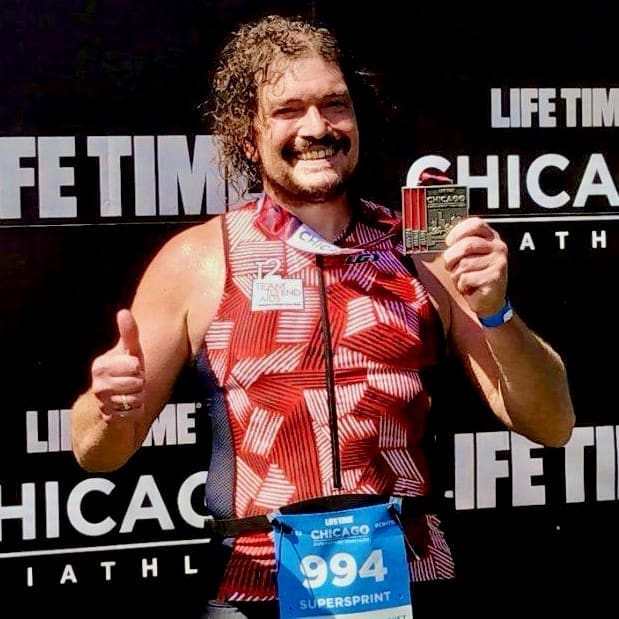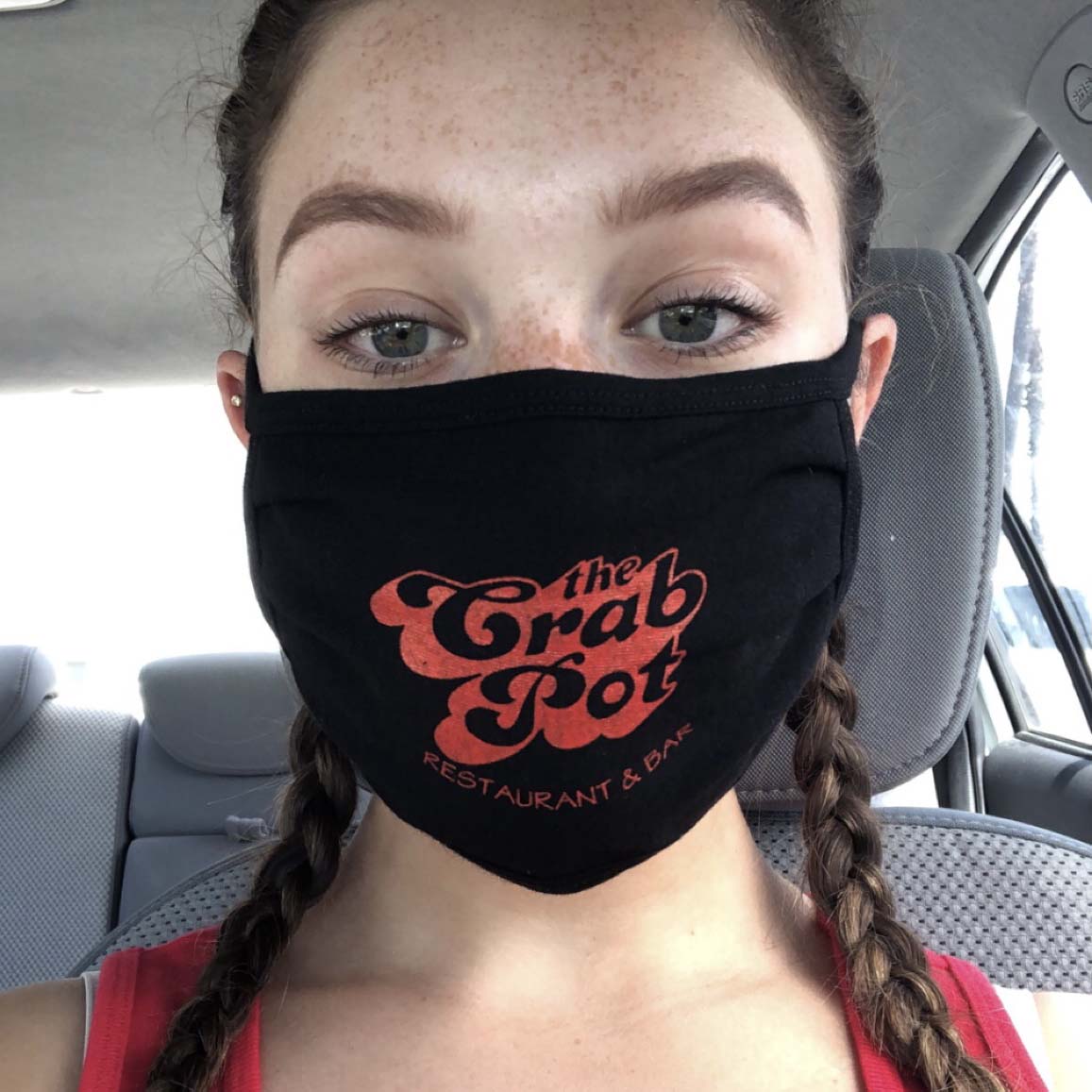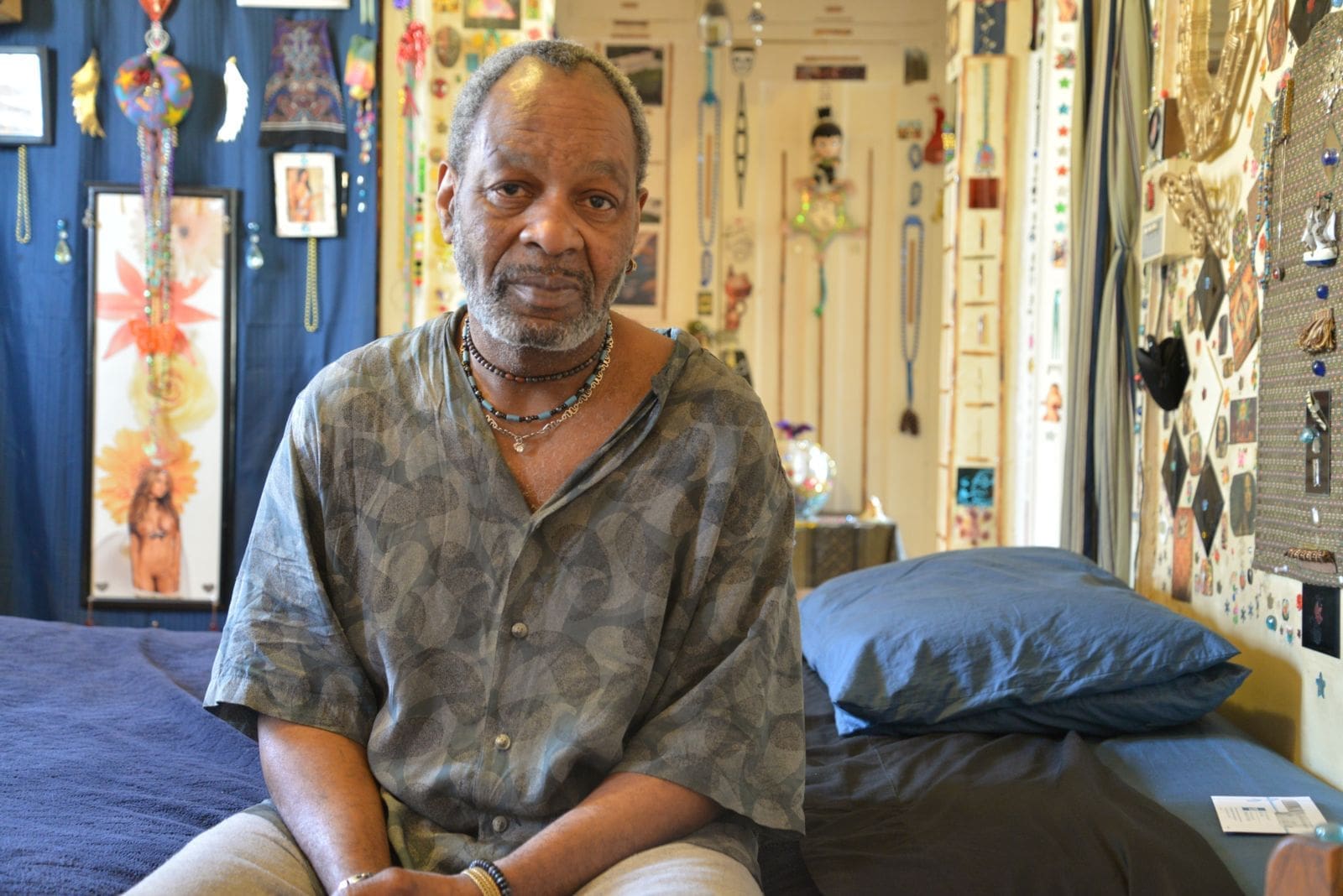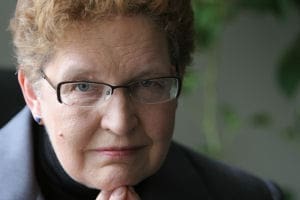My Marathon Journey of Recovery at the Chicago Triathlon

By David Biele
I fell in love with endurance sports in 2001, the same year I fell in love with crystal meth. The first love affair began during my training for the Heartland AIDS Ride, a 550-mile bike ride from St. Paul to Chicago. The second took off during a night of partying in Boystown. My relationship with endurance sports continued and deepened for 10 years and included a second AIDS Ride, 6 marathons, and four triathlons, plus countless 5K, 10K and other races. My relationship with crystal meth progressed and deepened over that decade as well. As they say in one of the meeting readings for a recovery program I attend, “What started out as weekend or occasional use became daily use, and we soon found ourselves beyond human aid.”
There were times when the two affairs intermingled. I actually used 3 hours before starting the 2009 Chicago Triathlon (my last until this year), my clouded mind telling me I needed the pick-me-up and that it would be out of my system by the time the race started. It most definitely was not. When I jumped into the water at 6 am I started hyperventilating and almost drowned before getting my breathing under control and continuing the race. By the time I ran the New York City Marathon in 2011, I was a daily user. I brought meth with me to the Big Apple and used the weekend of the race. Somehow, I finished, although it was by far my slowest time of all six marathons.
After that, the balance tipped in favor of my drug of choice, and I lost the discipline, perseverance, and commitment required for endurance sports. For the next seven years, I didn’t compete in a single long-distance event, never swam, and only went on short runs a couple times per year.
In the fall of 2018, I hit bottom in my addiction and started my recovery. Immediately, my love for endurance sports resurfaced. Since my life was no longer consumed by finding, using, and recovering from my drug of choice, I suddenly had all this extra time to fill and energy to expend. I biked over 7,000 miles in 2019.
The following year, during Chicago’s shelter in place order, I started running again so as not to gain the COVID 19 (pounds). The first time I ran 3 miles I could only run for three minutes before needing a one-minute walk break. I did that for the entire distance. Run Three. Walk One. Run Three. Walk One. Until the three miles were complete. Over the next six months I ran 5 – 6 days per week and gradually increased my run/walk ratio and distance. Eventually, I could run an entire 10K (6.2 miles) without stopping.
I was just as committed to my recovery as I was to get back in shape. I threw myself into 12-step programs. From June 2019 until July 2022, I didn’t miss a single day of meetings—going even on Christmas, New Years, and Thanksgiving. Through the worst of the pandemic when in-person meetings were non-existent and human connection so tenuous, I would go to two or even three virtual meetings per day. Also, within weeks of starting my recovery program, I got myself a sponsor and began working my way through the 12 steps. I took on service commitments, got sponsees, went to sobriety conferences, and joined the board of the Chicago Roundup, a 3-day sober conference for LGBTQ+ folk held every summer at Center on Halsted. During this time not a day went by that I didn’t actively engage in my recovery.
By January 2020, I felt my physical, mental, emotional and spiritual recovery had progressed enough for me to once again train for an endurance event, and I signed up for the Chicago Triathlon, but Miss Rona got in the way and canceled it. In 2021, I considered doing the Tri, but the Roundup was the same weekend, and I decided not to do both. This year, however, there was no stopping me. I signed up in January, and over the next 8 months I put in over 150 workouts in the pool, on my bike, and on my feet—logging close to 2,500 miles total in the process.
As I trained, I also raised money with Team 2 End AIDS to help Illinois “Get 2 Zero” new HIV infections by 2030. Because my drug of choice often leads many people like myself to engage in risky sexual behavior, many, many of the people I have met in my recovery have been HIV+ and/or are living with AIDS. So many of these people have helped me get and stay sober. Raising funds to support them and others is one way I can give back to those who have given me so much and helped me become the person I have always wanted to be.
Finally, Chicago Triathlon weekend finally arrived. I competed in both the Super Sprint Triathlon on Saturday and the International Distance Triathlon on Sunday. Saturday went great for me—I gave it my all and finished with a time I was proud of. Sunday was another story. Still a bit drained from Saturday’s race and thrown off my game due to the choppy water and hundreds of other triathletes swimming all around me, I was unable to catch my rhythm and quickly became out of breath. Panic quickly set in. I swam to a lifeguard boat and hung on desperately trying to calm my racing heart and slow my shallow breaths. When I thought I had succeeded, I started out again.
I didn’t get far however before the same doubt and anxiety returned, and I found myself reaching for the lifeguard’s oar at a second boat. I hung on again, trying to decide whether to keep going or call it a day. I had only made it a quarter of the 1500 meters I needed to cover? How could I possibly finish? The lifeguard asked if I wanted to be brought to shore. I said yes. I hung on to a floatation device as he swam me in. I got out of the water and a medical team converged around me asking if I was okay. Physically, I was, but mentally and emotionally I was a mess. I so badly wanted to finish. I asked them if they would let me skip the swimming and just do the bike and run and was told that was not allowed. “Fuck that!” I said to myself. There was no way I was going to give in this early in the game and back in the water I went.
Ever so slowly, I started swimming again. Adapting some of my recovery program’s mottos, I took it “one stroke at a time” and rather than focusing on the entire race, I kept my mind centered on “the next right thing.” I never was able to get my anxiety under control or my heart rate or breathing down to normal, and thus had to stop many, many times to hang on to the sea wall, the barnacles growing on it cutting major gashes on both my feet, but finally 1 hour and 35 minutes after jumping into the water, I pulled myself out and limped over to my bike for the second portion of the race.
As I stripped my wet suit off and got into my bike shoes, I knew that getting a time I would be proud of was already out of reach. When I finished, if I finished, I was sure I would have one of the slowest times of all 7,000 participants. But that was okay with me. Finishing became my new goal. Finishing would be more than enough because in my mind, my recovery and this triathlon had become inextricably linked. By completing this triathlon, no matter how slowly, I would at long last officially be reclaiming a part of myself I had lost to my addiction. By finishing, no matter how long it took me, I would know in my heart of hearts that I might fallen, and stayed fallen for a long, long, time, but here I was standing once again on my own two (and now very bloody) feet. Oh no, there was no way I was going stop.
By this point I was already exhausted. I knew that if I was going to finish the 25-mile bike ride, I would need to pace myself. I decided to pedal five rotations, then take a break for a count of five. Pedal another five rotations, and then take another break for a count of five. In this way I gradually made my way up Lake Shore Drive to Hollywood. Pedal five, break five. Other riders passed me right and left, but I did not let them deter me. I focused on what I needed to do. Pedal five, break five. I reached the turnaround at Hollywood. Pedal five, break five. I made it back to the start point and got onto Lower Wacker. Pedal five, break five. My leg muscles were really starting to burn by this point. How many miles were left? I did not know. Pedal five, break five. I exited lower Wacker and got onto the McCormick Place Busway. Out of the shade, I suddenly noticed how much hotter the day was getting—and that I was nearly out of water. Pedal five, break five. I reached the turnaround at McCormick Place and headed into the home stretch. Pedal five, break five. Finally, I saw the volunteers ahead motioning me to slow down, dismount, and walk my bike into the transition area.

As I switched from bike shoes to running shoes, I wondered how I would make it the final 6.2 miles on foot. My worry grew when I realized that somehow, despite all my pre-planning efforts, it turned out that I only had one sock with me, and both my feet were still bleeding in several places from getting torn up on the sea wall. On top of this, the temperature by this point had reached what I later learned to be 94 degrees. The last time I ran the Chicago Marathon in 2008 they cancelled the event mid-run and closed the course when the temperature reached 90 degrees, but triathletes are a different breed. This event was still going strong. After downing an energy gel packet, I grabbed my water bottle, left my bike, and headed out.
It was now close to 10 am. I’d been on the course for nearly 4 hours. Earlier in the week, based on my training, I had estimated it would take me a little more than 3 and half hours to finish. Also, there were runners doing the sprint triathlon (1/2 the international distance) on the course with me. The first sprint triathlon wave started two hours after I did. I refused to let either piece of information get me down and kept going.
The further south I went down the lakeshore path, the fewer spectators I encountered along the way. Without their cheers and words of encouragement, the course became quieter and quieter. The Chicago Triathlon does not allow participants to wear earphones or play music on the course, so eventually the only sound I heard was my own breathing, footsteps, and heartbeat as I headed down the lakefront path. Once I passed the turnaround point for the sprint triathlon, there were even fewer people around me. After passing south of McCormick Place, there were times when I was the only triathlete I could see ahead or behind me.
I stopped twice at medical tents where I got bandages and gauze for my bloody feet. The volunteers at the aid stations refilled my water bottle with Gatorade or water depending on what I needed at the time and provided much needed encouragement and emotional support. Although I had developed a low-grade headache, possibly an early sign of heat stroke, I was doing a great job staying hydrated, as evidenced by the fact that I was sweating unceasingly and regularly needed to pee. There were only a couple porta-potties on the entire route however, and I was too exhausted to find a secluded spot off course to urinate, so sometimes I just let the pee roll down my leg. The race had turned me into a bloody, sweaty, and most of all, smelly mess–but one that could not be stopped.
Finally, around 12:30 pm, I made it back to Grant Park, headed up the last hill, rounded the final turn, and gave everything I got down the home stretch. As I crossed t
he finish line, I heard the announcer call my name. Volunteers came up to me and put a medal around my neck. I lost it and burst into tears. My parents, who had flown in from Maryland to support me, found me moments later and snapped pic after pic of me, their hearts bursting with pride. And despite the fact that it had taken me nearly twice as long to finish the course as I had expected, so was mine. I had literally given my blood, sweat and tears to make it to the finish line, but I had made it there. And that’s all that mattered to me.
Although this year’s triathlon journey is complete, my journey as a triathlete is far from done. I know I’ll be back next year—and the year after that. And who knows? I may even have another marathon in me. And similarly, my recovery journey is far from over. My dedication to that path is stronger than ever. I know all I have is a daily reprieve, and if I want to live a life free from active addiction, I need to engage in my recovery every day. So to borrow a phrase from the 12-step programs in which I am involved, when it comes to triathlons and my recovery, I’m gonna “keep coming back”… and back and back and back.



